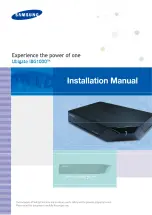
170
170
Glossary
CSMA/CA
Carrier Sense Multiple Access with Collision Avoidance
(CSMA/CA) is a low-level network
arbitration/contention protocol. A station listens to the media and attempts to transmit a packet
when the channel is quiet. When it detects that the channel is idle, the station transmits the
packet. If it detects that the channel is busy, the station waits a random amount of time and then
attempts to access the media again.
CSMA/CA is the basis of the IEEE 802.11e Distributed Control Function (
DCF
). See also
RTS
and
CTS
.
The CSMA/CA protocol used by
802.11
networks is a variation on CSMA/CD (used by
Ethernet
networks). In CSMA/CD the emphasis is on collision
detection
whereas with CSMA/CA the
emphasis is on collision
avoidance
.
CTS
A
clear to send
(CTS) message is a signal sent by an
IEEE 802.11
client station in response to
a
request to send
(
RTS
) message. The CTS message indicates that the channel is clear for the
sender of the RTS message to begin data transfer. The other stations will wait to keep the air
waves clear. This message is a part of the IEEE 802.11
CSMA/CA
protocol. (See also
RTS
.)
DCF
The
Distribution Control Function
is a component of the IEEE 802.11e Quality of Service (QoS)
technology standard. The DCF coordinates channel access among multiple stations on a wireless
network by controlling wait times for channel access. Wait times are determined by a random
backoff timer which is configurable by defining minimum and maximum contention windows.
DHCP
The
Dynamic Host Configuration Protocol
(DHCP) is a protocol specifying how a central server
can dynamically provide network configuration information to clients. A DHCP server “offers” a
“lease” (for a pre-configured period of time—see
Lease Time
) to the client system. The information
supplied includes the client’s IP addresses and netmask plus the address of its
DNS
servers
and
Gateway
.
DNS
The
Domain Name Service
(DNS) is a general-purpose query service used for translating
fully-
qualified names
into Internet addresses. A fully-qualified name consists of the hostname of a
system plus its domain name. For example,
www
is the host name of a Web server and www.
dlink.com
is the fully-qualified name of that server. DNS translates the domain name www.dlink.
com to some IP address, for example 66.93.138.219.
A
domain name
identifies one or more IP addresses. Conversely, an IP address may map to
more than one domain name.
A domain name has a suffix that indicates which
top level domain
(TLD) it belongs to. Every
country has its own top-level domain, for example
.de
for Germany,
.fr
for France,
.jp
for
Japan,
.tw
for Taiwan,
.uk
for the United Kingdom,
.us
for the U.S.A., and so on. There are
also
.com
for commercial bodies,
.edu
for educational institutions,
.net
for network operators,
and
.org
for other organizations as well as
.gov
for the U. S. government and
.mil
for its
armed services.
Summary of Contents for AirPremier DWL-2210AP
Page 193: ...193 ...
















































